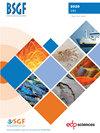Microstructural evidences for mineralogical inheritance in partially molten rocks: example from the Vosges Mts
IF 2.6
3区 地球科学
Q2 GEOSCIENCES, MULTIDISCIPLINARY
引用次数: 5
Abstract
During orogenic processes continental crust experiences significant partial melting. Repeated thermal pulses or fluctuation in fluid content can even cause multiple anatectic events that result in complex intrusion suits. In the Vosges mountains, France, two main generations of magmatic rocks are recorded. The first magmatic event occurred at ca. 340 Ma, and is represented by extensive K-Mg granitoids magmatism. The second magmatic event occurred at ca. 325 Ma and produced large quantity of felsic anatectic melts which further pervasively intruded and compositionally and texturally reworked previously formed granitoids. Detailed field and microstructural observations revealed continuous transitions from porphyritic granite with large euhedral Kfs and Pl phenocrysts (Type I granite) via intermediate granite (Type II) to fine-grained apparently isotropic granite (Type III) dominated by the neo-crystallized melt. The Type I granite preserves the original magmatic assemblage and has only incipient amount of the newly crystallized melt. The new melt-crystallized material forms narrow, fine-grained pathways along grain boundaries or cuts across pre-existing magmatic grains and forms an interlinked network. With increasing amount of the newly crystallized material the original magmatic grains are resorbed and show highly corroded shapes. The early formed feldspars grains have strong compositional zoning, with oscillatory zoned cores reflecting range of original magmatic compositions and rims showing later melt overgrowths. Original magmatic feldspars have different composition from the new phases crystallizing in the partially molten granite. We interpret the fine-grained microscopic corridors as melt pathways that were exploited by the new magma. We suggest that this melt pervasively migrated through the older granitoids resulting in mixture of inherited “xenocrysts” and of new melt-derived crystals. The interaction between the new melt and previously crystallized granitoids results in variety of granite textures and fabrics. These reflect different degrees of equilibration between the bulk rock and the passing melt. Finally, Type III granite carries mixed isotopic signature intermediate between the type I granite and the surrounding metasediments and granulites, suggesting mixing of the original granite with new later magma with source in these rocks.部分熔融岩石矿物学继承的微观结构证据:以孚日山为例
在造山过程中,大陆地壳经历了显著的部分熔融。反复的热脉冲或流体含量的波动甚至可以引起多次的冲蚀事件,从而导致复杂的侵入。在法国孚日山脉,记录了两代主要的岩浆岩。第一次岩浆活动发生在约340 Ma,以广泛的钾镁花岗岩岩浆活动为代表。第二次岩浆活动发生在约325 Ma,产生了大量的长英质冲蚀熔体,这些熔体进一步侵入并在成分和结构上改造了以前形成的花岗岩类。详细的野外和微观结构观察表明,从具有大自面体Kfs和Pl斑晶的斑状花岗岩(I型)到中间花岗岩(II型)到以新结晶熔融为主的细粒明显各向同性花岗岩(III型)的连续转变。ⅰ型花岗岩保留了原有的岩浆组合,只有少量的新结晶熔融物。新的熔融结晶物质沿着晶界形成狭窄、细粒的路径,或穿过先前存在的岩浆颗粒,形成一个相互连接的网络。随着新结晶物质的增加,原始岩浆颗粒被吸收,呈现出高度腐蚀的形态。早期形成的长石颗粒具有较强的成分分带性,振荡分带的岩心反映了原始岩浆成分的范围,边缘显示了后期的熔融过度生长。原始岩浆长石与部分熔融花岗岩中结晶的新相组成不同。我们将细粒度的微观走廊解释为新岩浆利用的融化路径。我们认为,这种熔体在较老的花岗岩类中广泛迁移,导致继承的“异晶”和新的熔体衍生晶体的混合物。新的熔体和以前结晶的花岗岩之间的相互作用导致了花岗岩结构和织物的多样性。这反映了大块岩石和经过的熔体之间不同程度的平衡。ⅲ型花岗岩的混合同位素特征介于ⅰ型花岗岩与周围的变质岩和麻粒岩之间,表明原花岗岩与源岩中新后期岩浆有混合作用。
本文章由计算机程序翻译,如有差异,请以英文原文为准。
求助全文
约1分钟内获得全文
求助全文
来源期刊
CiteScore
5.80
自引率
0.00%
发文量
18
审稿时长
>12 weeks
期刊介绍:
BSGF - Earth Sciences Bulletin publie plusieurs types de contributions :
1. des articles originaux, couvrant tous les champs disciplinaires des Géosciences, à vocation fondamentale mais également à vocation plus appliquée (risques, ressources);
2. des articles de synthèse, faisant le point sur les avancées dans un domaine spécifique des Géosciences, qu''elles soient méthodologiques ou régionales ;
3. des monographies sur la géologie d’une région donnée, assorties d’informations supplémentaires, cartes, coupes, logs, profils sismiques … publiées en ligne en annexe de l’article ;
4. des articles courts de type « express letter » ;
5. des livrets-guides d’excursion (qui suivront le même processus d’examen éditorial que les articles plus classiques) ;
6. des comptes rendus de campagnes à la mer ;
7. des articles de données géodésiques, géophysiques ou géochimiques, pouvant devenir des articles de référence pouvant conduire à des interprétations ultérieures.
BSGF - Earth Sciences Bulletin constitue également un forum pour les discussions entre spécialistes des Sciences de la Terre, de type comment-reply ou autre. Tous les articles publiés, quelle que soit leur forme, seront accessibles sans frais (articles en Open Access) sur le site de la SGF et sur celui de Geosciences World dans la mesure où les auteurs se seront acquittés d’une contribution de (Article Processing Charges – APC) de 300€ pour les membres de la SGF et 500€ pour les non-membres.

 求助内容:
求助内容: 应助结果提醒方式:
应助结果提醒方式:


